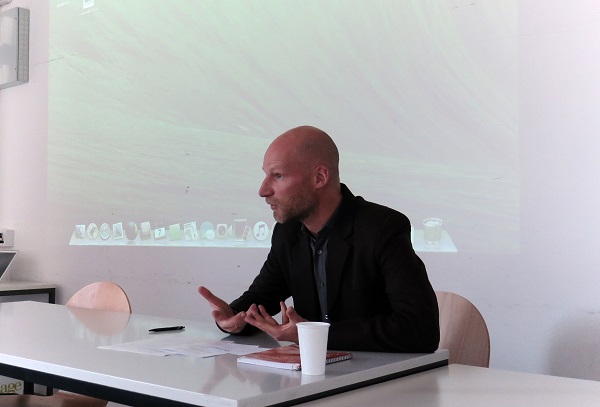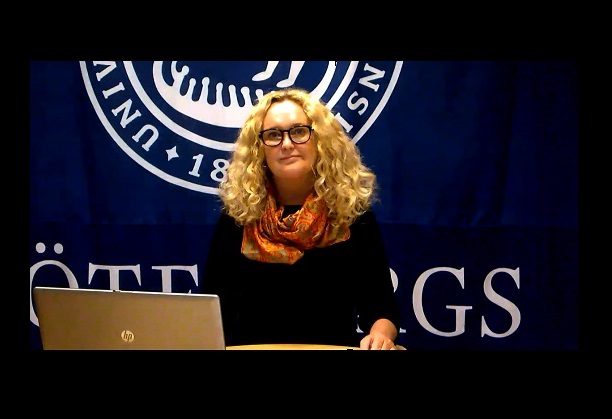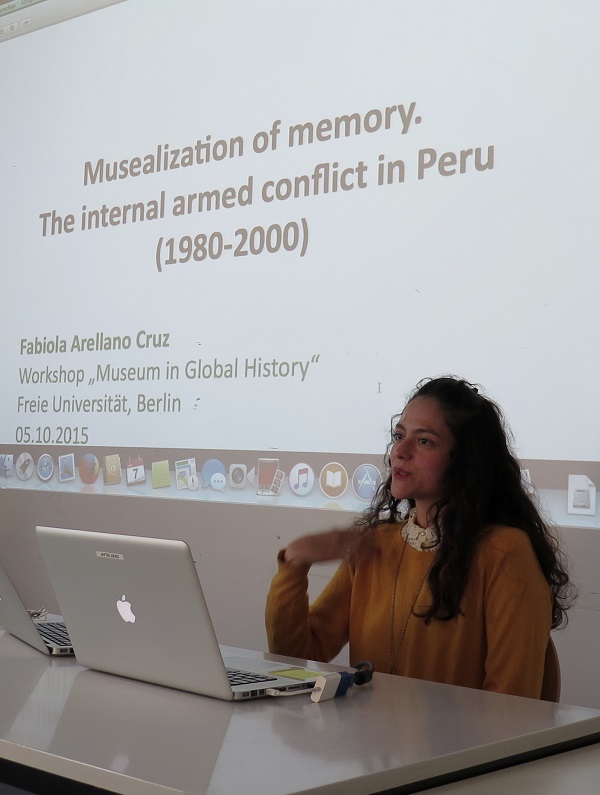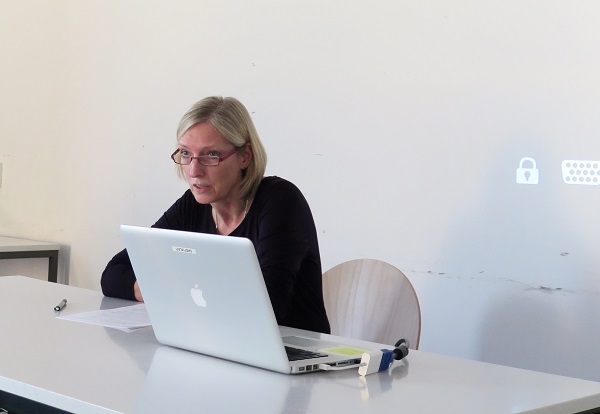2015.11.04
「グローバルヒストリーにおけるミュージアム」ワークショップ Workshop "Museum in Global History"
2015年10月5日、ベルリン自由大学にてワークショップMuseum in Global History(グローバルヒストリーにおけるミュージアム)が開催された。今回のワークショップはGHC東大拠点のジュニアメンバーであり、2014年度海外派遣学生としてベルリン自由大学に滞在した寺田悠紀が企画を担当した。世界遺産である博物館島を有し、新しい文化施設(フンボルト・フォーラム)の建設が進み近年博物館学の議論が盛んなベルリンで、ミュージアムをテーマに世界史を考える機会を設けることが重要であると考えたことに始まる。ミュージアムという概念がどのように世界に広がり、様々な文化がどのように表象されてきたのかについて歴史的背景を比較検討することを趣旨とし、国内外の研究者が集った。
まず初めに、フリードリッヒ・マイネッケ研究所のSebastian Conrad教授による開会の挨拶、東京大学の羽田正教授からビデオメッセージをいただいた。続いて、National Museums and Nation-Building in Europe 1750-2010 の共著者であるGabriella Elgenius教授(オックスフォード大学)のビデオプレゼンテーションを上映した。Elgenius教授は2010年から2013年に亘って欧州委員会によって主催されたヨーロッパの国立博物館プロジェクト(European National Museums, Identity Politics,. Uses of the Past & the European Citizen (EUNAMUS 2010-2013))のコーディネーターの一人である。Elgenius教授は、ヨーロッパにおける国立博物館の誕生と発展を、周辺諸国との競争関係から読み解き、国家の成立過程において国立博物館が果たした役割(共同体の視覚化)についての分析を行った。
次に、4人の博士課程学生がそれぞれ世界各地の事例研究の発表を行った。
寺田悠紀(東京大学大学院)は、Visualizing the “World” in Museums-Case Studies from Iran と題した発表で、19世紀後半にペルシアに紹介されたミュージアムという概念が国際化とナショナリズムの両方と関わりながら発展してきたことを論じた。また、イランの国立博物館と美術館の事例を通して、ミュージアムという空間の中に表象された世界の文化、また、世界におけるペルシア、イラン独自の文化の位置づけの変容を考察した。
Ji Young Park氏 (ルーヴル学院, L’UAPV, L’UQAM) は、Museums: the imagination of Europe vis-à-vis Koreaと題した発表で、日本の植民地支配下で設立された韓国の博物館の歴史を再考した。まず、国家、公共、文明という概念が韓国語に翻訳された背景を説明した。そして、20世紀を通して日本の影響からの脱却と、独立した文明国家の形成が目指された過程において、博物館に表象された近代西洋のイメージと理解について分析した。
小森真樹氏(東京大学大学院、テンプル大学)の発表(Embodying the 1976: Medical Museum and American National Identity in the Bicentennial Tourism in Philadelphia)は、アメリカ、フィラデルフィアの医療博物館(ムター・ミュージアム)の事例を扱った。人体を展示するという行為がどのように受け入れられてきたのか、建国200年記念(1976年)を機に打ち出されたミュージアムの運営方針を考察し、科学とナショナリズムという要素が重要であったことを論じた。
Fabiola Arellano氏 (ルートヴィヒ・マクシミリアン大学)の発表タイトルはMusealization of Memory. The internal armed conflict in Peru (1980-2000) であった。ペルー内戦の記憶を保存するために作られた記憶博物館(The Place of Memory, Tolerance and Social Inclusion)を事例に、被害者への賠償問題、記憶の展示を、グローバルヒストリーの文脈に位置づけ考察した。ペルー政府は博物館建設計画に難色を示していたが、ドイツ政府の支援や国際世論に後押しされて計画が実現した。
続いて、ゲストとしてお迎えした日本演劇と文化政策に詳しいAnnegret Bergmann氏(ベルリン自由大学) よりコメントをいただいた。Bergmann氏は、明治維新以降の文化政策の中で、ミュージアムが博物館と美術館に区別された日本の状況について説明した。そして、近・現代美術作品が美術館に展示される一方で、日本最古の東京国立博物館(1872年創設)には明治以前の美術品や遺物が展示され、帝国としての日本国家が表象されてきたことを述べた。陳列して一般公開されたモノによって歴史が語られ、伝統が創造される過程は、明治期の日本に限らず多くの国々に見いだせるとし、総合討論へ移った。
フロアを交えての総合討論では、ヨーロッパ諸国、イラン、韓国、アメリカ、ペルー、日本の事例を中心に比較検討を行った。論点は大きく分けて3つ挙がった。まずは、ミュージアム概念の受容の歴史である。独立国家として国際的に認められ、文明国としての地位を築くことへの願望が、ミュージアムが多くの国で取り入れられた背景であることが確認された。Elgenius教授によって提示された博物館の競争関係という視点が、ヨーロッパ諸国だけでなく世界各地の事例に応用できるだろうという意見や、ナショナリズムを打ち出した展示がある一方で人類の歴史を包括した展示(英国博物館等)が見られることにもパターンが見いだせるのではないかという指摘があった。次に、ミュージアムのもつ科学的保障や普遍性について意見交換が行われた。取捨選択された記憶や美術品がひとたびミュージアムという空間に展示されると、それらは科学的に保障された真実として理解されるが、19世紀に作られた区分や陳列方法、普遍性について見直されなければいけないとの意見が多く挙がった。最後に、展示されるもの、許容されるもの、展示できないもの、という区別に見られる政治的メッセージについても議論された。ドイツのフンボルト・フォーラムの試みと成果に詳しい参加者も積極的に議論に参加し、多くの知見が得られたワークショップとなった。
(文責:寺田 悠紀)
On October 5th, 2015, the workshop "Museum in Global History" was held at Freie Universität Berlin. It was organized by Yuki Terada, a junior member of the GHC hub at the University of Tokyo who was at Freie Universität Berlin as a 2014 GHC scholarship student. The field of museum studies is flourishing in Berlin. Not only does it have a Museum Island that is UNESCO World Heritage Site, a new cultural facility (Humboldt-Forum) is in the process of being built in the city. The workshop, which hosted scholars from both within and outside of Germany, was organized based on the idea that it is important to create an opportunity to think about world history in terms of museums and aimed to comparatively consider the historical background to the concept of museums spreading throughout the world as well as the ways in which various cultures have been represented.
The workshop began with opening remarks by Professor Sebastian Conrad (Friedrich-Meinecke-Institut), and followed by a video message from The University of Tokyo's Professor Masahi Haneda. A video presentation by Oxford University Professor Gabriella Elgenius (co-editor of National Museums and Nation-Building in Europe 1750-2010) was then shown. Professor Elgenius was one of the coordinators of the European National Museums: Identity Politics, the Uses of the Past and the European Citizen (EUNAMUS 2010-2013), a project organized by the European Commission. In her presentation, she discussed the birth and development of national museums in Europe in terms of “rivalling clusters”, and analyzed the role played by them in the establishment of the nation-state, namely, making its imagined community visible.
Four doctoral course students presented their case studies respectively on various places throughout the world.
Yuki Terada (The University of Tokyo's Graduate School) gave a presentation entitled "Visualizing the 'World' in Museums: Case Studies from Iran," in which she discussed how the concept of museums was introduced to Persia in the latter part of the 19th century and developed while being shaped by internationalization and nationalism. Furthermore, presenting the examples of the National Museum of Iran and the country's art museums, she considered how world cultures are represented in museum spaces as well as changes in how Persian and Iranian culture has been positioned within the cultural map of the world.
In a presentation entitled "Museums: the imagination of Europe vis-à-vis Korea," Ji Young Park (École du Louvre, L’UAPV, L’UQAM) reconsidered the history of Korean museums built under Japan's colonial rule. First, she explained the background to the translation into Korean of the concepts of state/nation, public, and civilization. Then, she analyzed the image and understanding of the modern West represented by museums in the 20th century process of Korea leaving behind Japan's influence and aiming to form an independent and civilized nation-state.
The presentation of Masaki Komori (The University of Tokyo's Graduate School, Temple University) was entitled "Embodying the 1976: Medical Museum and American National Identity in the Bicentennial Tourism in Philadelphia" and considered the example of the Mütter Museum, a medical museum in Philadelphia, USA. Aiming to explain how the act of displaying the human body was received, he discussed the museum's operating policy that was crafted on the bicentennial of the United States' founding (1976), and argued that science and nationalism were important elements that shaped it.
The title of Fabiola Arellano's (Ludwig Maximilians Universität) presentation was "Musealization of Memory. The internal armed conflict in Peru (1980-2000)." Using the example of The Place of Memory, Tolerance and Social Inclusion, a museum made to preserve the memories of the internal armed conflict in Peru, she considered the issue of reparations for victims and exhibiting memory, locating them in the context of global history. Peru's government expressed reservations about the plan to build the museum, but it was eventually realized with support from the German government and international opinion.
Next, Annegret Bergmann (Freie Universität Berlin), an invited commentator who specializes in Japanese theater and cultural policies shared her comments. Bergmann explained how museums were divided into two types in cultural policies from the Meiji Restoration (1868) onwards in Japan: hakubutsukan (history, ethnography, science, etc. museums) and bijutsukan (fine art museums). She then described how while modern and contemporary works of art were on display at the latter, on the other hand pre-Meiji artworks and relics of the past were displayed at Japan's oldest hakubutsukan, the Tokyo National Museum (est. 1872), thereby representing the empire of Japan. The process of history being narrated by objects on display to the general public and tradition being created, said Bergmann, can be found in not only Meiji period Japan but many other countries as well. After her comments concluded, there was time for a general discussion that was open to the floor.
The general discussion primarily centered around a comparative analysis of examples from European countries, Iran, Korea, the United States, Peru, and Japan. Discussion points can be divided roughly into three issues. The first was the history of the acceptance of the concept of "museum." It was confirmed that in the background to many countries adopting museums was their desire to be internationally recognized as independent and acquire the status as a civilized country. It was stated that the perspective of museum's competitive relationships discussed by Professor Elgenius could probably be applied to cases not only in Europe but also those in countries around the world. It was also pointed out that a pattern can be detected in the existence of nationalism-creating exhibits on the one hand and those that encompass all of humanity (British Museum, etc.) on the other. Next, participants exchanged their opinions regarding the scientific assurance and universality of museums. When selected memories and artworks are displayed in the space of a museum, they are understood as scientifically assured realities. Many were of the opinion that there is a need to reconsider the classifications, display methods, and universality created in the nineteenth century. Lastly, there was a discussion of the political messages within the distinctions between things that can be or cannot be exhibited. Participants familiar with the Humboldt-Forum related experimental projects and their outcomes also actively participated in the discussion. It was a fruitful workshop that offered considerable knowledge to its participants.




















